Scoliosis, Back Surgery, Mastectomy and Healing with the GYROTONIC® Method
Blog Content Interviews Testimonial // July 19, 2017
Judi Heile
GYROTONIC® Student at Body Mind Balance
Cincinnati, OH
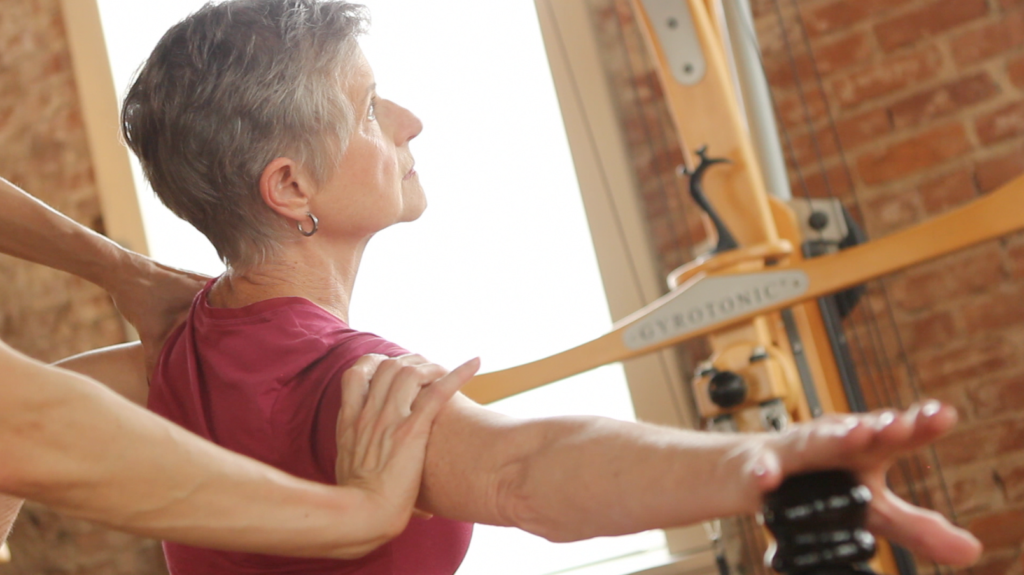 I did not realize I had scoliosis. I was not diagnosed as child. However, in the early 90s, I began experiencing much more difficulty with it.
I did not realize I had scoliosis. I was not diagnosed as child. However, in the early 90s, I began experiencing much more difficulty with it.
I had 4 pregnancies, one miscarriage and three successful, and all came with a lot of back pain. Of course, no one wanted to x-ray me during my pregnancies. I finally found out during the last pregnancy that the pain was not really due to bursitis, as the doctors had suspected. It was scoliosis. I was quite surprised. I knew that my skirts were always crooked, but had been told I just had one leg longer than the other, or other various things that weren’t accurate.
So, over the years, from about 1975, and into the ‘90s, I saw various orthopedic physicians and physical therapists, I was given medications, and I went through something called rolfing because I was so frustrated that nothing else was working. Nothing was helping, and it was getting worse.
By the year 2000, I was feeling very frustrated and thinking no one was ever going to be able to help me. There was no mention of surgery, at that time. It was all about medication and physical therapy. Certainly, I was told that keeping my back muscles strong would help me get through it, but it wasn’t. Then, in 2000, I was diagnosed with breast cancer.
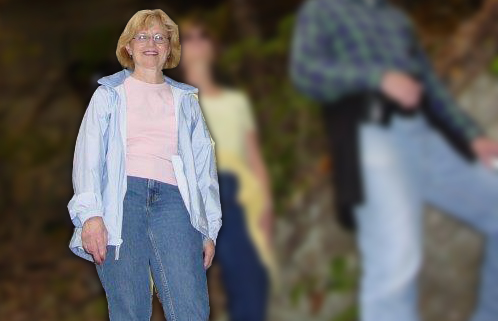 By this time, I was practicing Pilates at my local studio in Cincinnati called, Body Mind Balance. This is the studio where I’m still taking GYROTONIC® classes, today. They really helped me, so much more than anyone else did, in regard to getting back my range of motion. More about that later.
By this time, I was practicing Pilates at my local studio in Cincinnati called, Body Mind Balance. This is the studio where I’m still taking GYROTONIC® classes, today. They really helped me, so much more than anyone else did, in regard to getting back my range of motion. More about that later.
After being diagnosed, I had a full mastectomy of the left breast. It came as a terrible shock because the lumpectomy was such that the surgeon told me, “Oh, we’re planning on widening the margins a bit, but you’re going to be fine.” Then, I woke up without a breast. So, it wasn’t fine, and the incision was very bad, with lots of scar tissue, because the surgeon wasn’t expecting to take the breast. It was a very difficult situation.
This particular surgeon expected that I would not do any exercise for several weeks, and then the only thing that he wanted me to do was the typical climbing my arm up the wall with my fingers. By the time I got back to Pilates, which I had started prior to that surgery, I felt almost paralyzed on my left side. He had cut through the trunk nerve under my arm, so I was numb and had difficulty lifting that arm.
Fast-forward a bit. I went into my oncologist’s office one day, close to tears, and he said, “What’s wrong? You’re doing fine.” I told him that maybe the cancer was doing fine, but I was not. My back was just so bad, even though I was doing everything I could think of to strengthen it. I did not know what else to do. It hurt all of the time and I was tired of it. He asked if I had ever thought of getting another opinion. I had been going to the same orthopedic group for years, seeing several different doctors in that group, and I had not thought of getting a second opinion. So, he recommended someone to me, and I went.
By the time I went to this new physician, the curvature was so bad that he said to me, “If we don’t do something soon, you’re going to be in a wheelchair or fall on your head!” He described the surgery he had in mind, which involved both an anterior and posterior surgery. In 2006, I chose to go through it. It was interesting, though, because I was already 59 years old; I’m now 68.
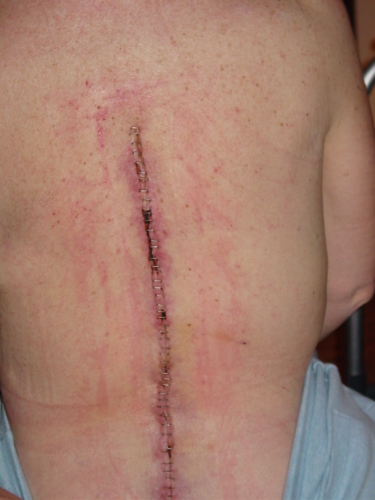
Judi’s back surgery incision.
The first part of the surgery involved removing all of the discs from the very bottom lumbar area all the way up to T9, and removing the 10th rib. After that, I was in intensive care for about seven days before I was well enough from that surgery to turn me over and put me back together. That involved the rods and all of what I call, ‘the nuts, bolts, and screws.’ It was quite an interesting x-ray once I saw what he had done to me.
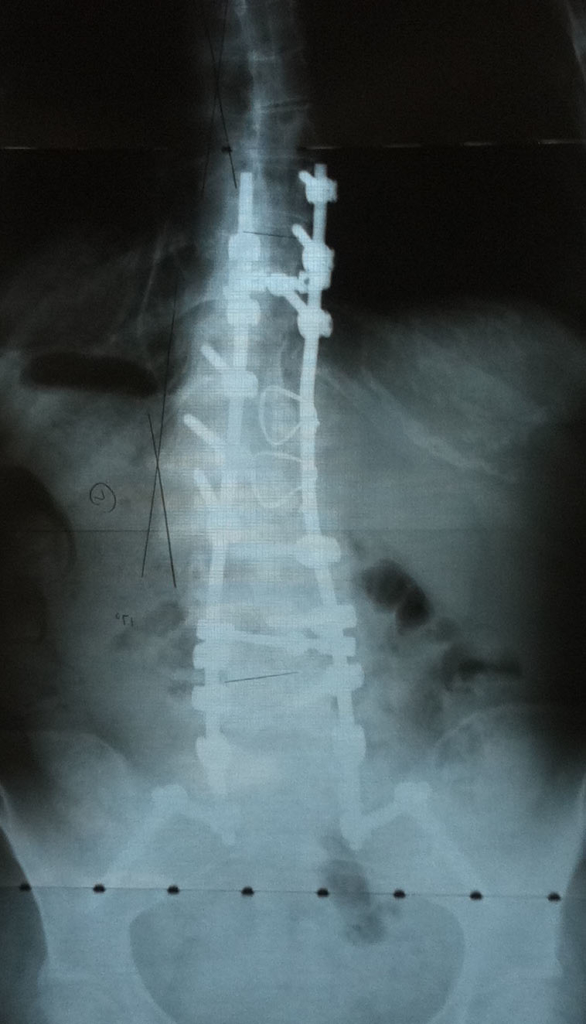
Judi’s post back surgery x-ray.
I was two inches taller, which was kind of exciting. I always hated being as short as I was. Of course, with the scoliosis, I had gotten even shorter. I was in a turtle brace for three months. That’s the kind of brace that goes from your chest all the way down past your hips. I did start physical therapy very soon after the surgery, but only in water. They would put me in one of those chairs that swing you out over the water and then lower you so you don’t hurt yourself.
All of this left me with a problem with my right hip. No matter how much I exercised, it continued to bother me. I was doing Pilates, massage therapy, and even getting Cortisone injections as frequently as you’re allowed to get them. Nothing was really helping.
So my Pilates instructor, Julie Toren, who is also the owner of Body Mind Balance, suggested that I try the GYROTONIC® Method. I said, “Oh, Julie. I’ve been watching people do it across the room and there’s no way I can do that. I can’t bend my back and curve like everyone else.” She said she still thought I should try it, because she thought I would like it and that it just might help my hip.
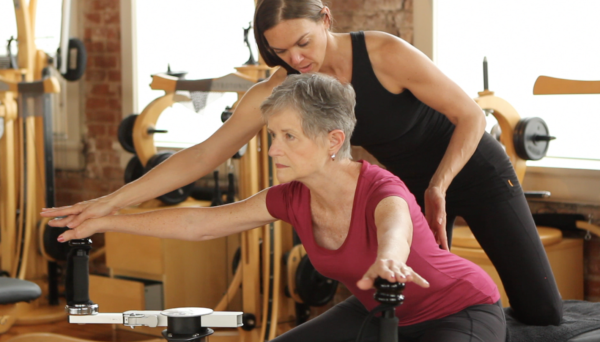
Judi working with GYROTONIC® Master Trainer, Julie Toren. Photos by Cina Canada.
For me, the Gyrotonic Method was about working with my joints. It was absolutely amazing that within only 7 or 8 months of starting this work, I no longer needed Cortisone shots. My hip never hurts me now. I still have some back issues in terms of a heaviness, or feeling of pressure in the upper part of my back where the natural vertebrae stops because basically that’s what’s holding my head up, but it has been remarkable what this work has done for me.
Fast forward, again, to 2013. Things were going great for me until I found a lump in my other breast. I won’t go into the gory details, but my oncologist also felt it. As a matter of fact, I could do a commercial for women doing self breast exams. I can’t help myself. Mammograms did not show any of my cancers.
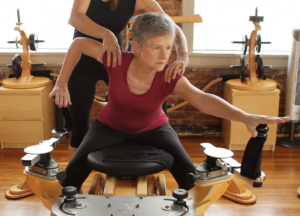 So I had the other breast removed on New Year’s Eve. This time, prior to the surgery, Julie helped me strengthen my upper body because I was not going into another surgery feeling as though I was going to lose my range of motion. We adjusted my weekly sessions with her, and added some things at home that she showed me how to do. I know that I went into that surgery far better off than I was in 2000.
So I had the other breast removed on New Year’s Eve. This time, prior to the surgery, Julie helped me strengthen my upper body because I was not going into another surgery feeling as though I was going to lose my range of motion. We adjusted my weekly sessions with her, and added some things at home that she showed me how to do. I know that I went into that surgery far better off than I was in 2000.
I also decided to have breast reconstruction on both sides because I had not had the opportunity to do that, before. That, of course, creates more scars and difficulty. As you can imagine, I was quite anxious to get back to the Gyrotonic exercises after all of that. I came running back and here I am!
In regular physical therapy, the equipment does not lend itself to what the Gyrotonic Method has been able to do for me. Years ago, I had traction and what a horrible thing that is! Just to have something pulling on your ankles and head, that didn’t help one bit. It can feel okay at the moment, but once it’s over, it’s over. With the Gyrotonic work, by comparison, you train yourself to do that for your own body, from within, lifting and finding internal contrast. You then find those parts of you that can provide your own sense of internal traction.
I feel really good about my body condition. I think it’s incredibly important to keep my weekly appointment with my Gyrotonic trainer. There is something about that commitment that makes all of the difference. Having this appointment makes it a very important part of my life. It really has been remarkable to work with a skilled trainer, like Julie, who can customize the program for someone like me. I’m even at a point where I can take some group classes because I can now keep up. There was a time when I thought I wouldn’t be able to do it at all, much less take a group class!
I was someone being told I would end up in a wheelchair, and now here I am. It’s so worth it. I enjoy it, I intend to keep doing it, and I’ll probably end up the oldest Gyrotonic student here, someday!
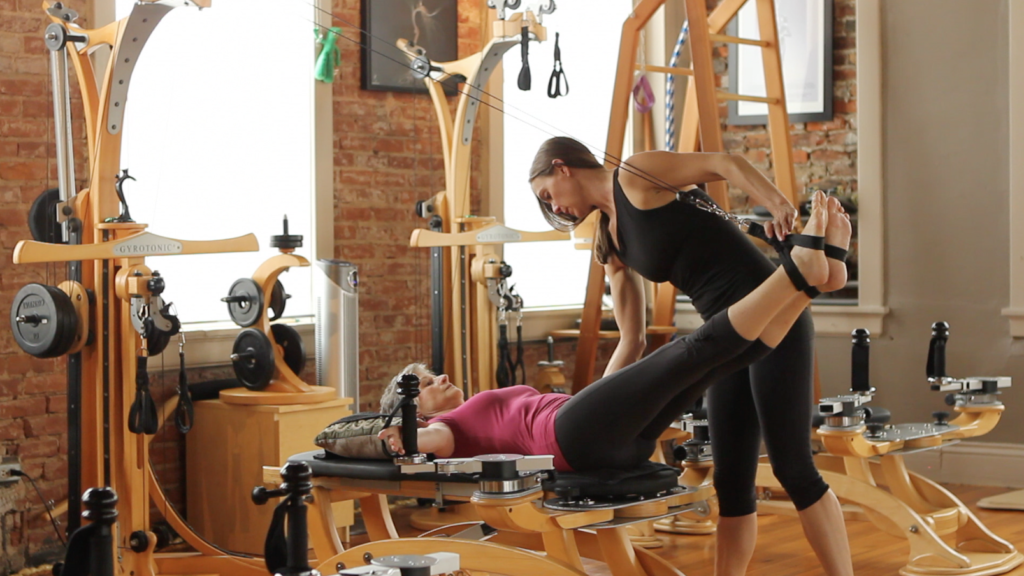
Julie Hegge-Toren, GYROTONIC® Master Trainer
Judi’s Trainer
Owner, Body Mind Balance in Cincinnati, Ohio
Judi has been a part of our studio family for almost as long as it’s been open. She first came for Pilates, prior to her surgeries, but as she’s worked more with me, she has transitioned to the GYROTONIC® Method. I encouraged her to look at it because I knew it would allow her to have a lot more fluidity, especially in her hips, which was one of the things she was most concerned about, at the time. I also knew that although her spine wasn’t in a position where it could articulate, because of the rods and those limitations, the work was not limited. I think that is a really important point for people to understand.
There is so much to the physical body that the Gyrotonic Method approaches and works on and helps to develop, not just the spine, itself. Everyone has tightness in their spines. Upper body, lower body. The spine is going to be tight. Some people have it imposed on them. But the important thing to remember is to be strong around the areas that have the tightness, and to support movement and blood flow and muscle activation around those areas that are limited. You want the whole body to feel movement and to benefit from movement.
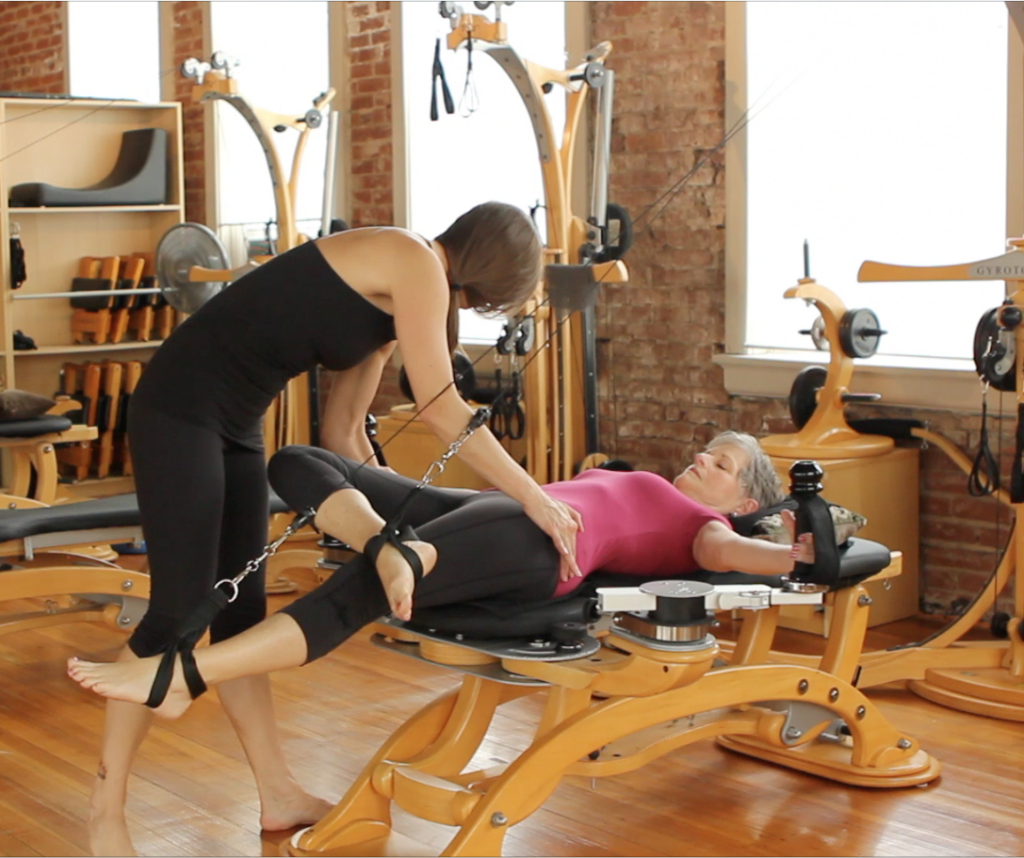 With the hips, I knew that most of my programming with her was going to be lying down so that she could have the support for her body and for her back, and she could have the strength to start moving her legs. As I watched her walk, and saw the lack of articulation in her hips because of the rigidity in her spine, I saw that a lot of her other joint mechanics were also very rigid. There wasn’t a smoothness, or a bounce if you will, in her step. That was affecting her knee, her ankle, her hip, everything. I knew that working with her, just on leg articulation, and hip articulation, helping her understand how to have tone around the hip itself as she walked, was going to help her whole body articulation.
With the hips, I knew that most of my programming with her was going to be lying down so that she could have the support for her body and for her back, and she could have the strength to start moving her legs. As I watched her walk, and saw the lack of articulation in her hips because of the rigidity in her spine, I saw that a lot of her other joint mechanics were also very rigid. There wasn’t a smoothness, or a bounce if you will, in her step. That was affecting her knee, her ankle, her hip, everything. I knew that working with her, just on leg articulation, and hip articulation, helping her understand how to have tone around the hip itself as she walked, was going to help her whole body articulation.
The other thing that became very apparent, once we started working with the Gyrotonic Method, was seeing that I could help her mobilize the part of her upper back that could move, in addition to her lower body. As she was preparing for her surgeries, she was developing healthy shoulder articulation, strength through the chest, and overall strength throughout the upper body. We did this by working quite heavily with specific arm exercises. Then, as she came out of those, we worked to get movement and articulation into those areas to support healing of scar tissue and to get range of motion back so she would have quality of life function.
One of the biggest things that I think Judi has been surprised by is that she is now able to take group classes. She did not think she would be able to keep up in a group, but she is, and it’s been great to see that camaraderie and energy. It’s great to see that she’s doing the same exercises as everyone else. She might not have the rotational capacity in her body, but I don’t modify a whole lot for her. Someone might be arching and curling their spine while she is rocking back and forth in the hips and everyone is getting benefit.
I have each person thinking about specific things because that’s what you do in any group, but I teach everyone in that group the same. I think it’s good for people’s mental state, especially as they are dealing with specific issues, or injuries, or things that feel limiting, to realize they are able to be in a class with others, and be successful.
To find studios, classes and trainers near you that offer the GYROTONIC® and GYROKINESIS® Methods, use our Studio Finder tool.
To learn more about becoming a licensed GYROTONIC® or GYROKINESIS® Trainer, check out our Teacher Training materials.
————–
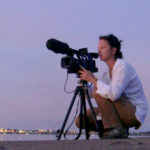
Interviews by Cina Canada. Cina is a GYROTONIC® Trainer and the Media Coordinator for GYROTONIC® International Headquarters.

Hi! I just did a web search for gyrokinesis after reading about it in a stretching book by Linda Minarik. I would be truly grateful for any more information about exercises for scoliosis. I am 73, have never had surgery and am now too old, my Cobb angles are 55 degrees thoracic and 52 lumbar, and my pain is totally thoracic. In spite of many attempts, I have never found a physio or chiropractor who knew what they were doing. I’ve often increased my pain through exercises that did nothing positive. I’m in South Australia, where scoliosis is still more or less ‘owned’ by orthopaedic surgeons.
Any advice for safe and helpful exercises would be much appreciated.
Hi, Margaret. Thank you for reaching out. We recommend a couple of things to learn more. First, see if there is a Gyrotonic or Gyrokinesis trainer in your area. You can do this by searching our Studio Finder at gyrotonic.com/studiofinder. Second, try posting your inquiry on our public Gyrotonic Group on FB at facebook.com/gyrotonic. There are many trainers from around the world in that group and if you are unable to find a trainer near you, you may be able to find a Gyrokinesis class online. Please let us know if we can help you further: info@gyrotonic.com. Wishing you all the best!